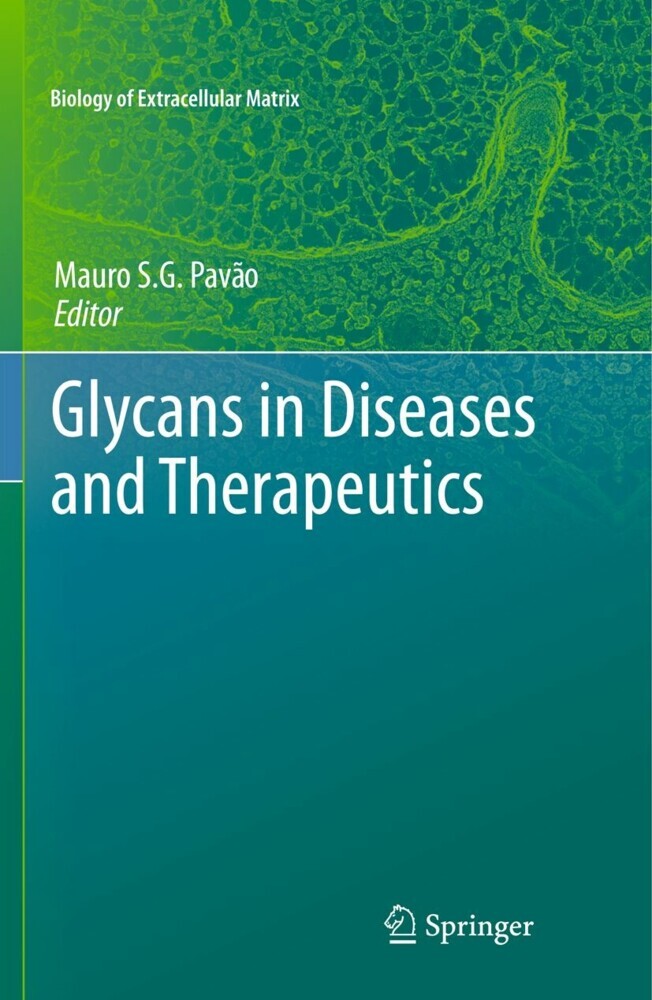Initially believed to be inactive molecules, glycans are now considered essential for life, both under normal and pathological conditions.
This volume of the series ' Biology of Extracellular Matrix' reviews the most recent findings on the role of glycans in the development of diseases and the possible therapeutic use of this class of molecules. It shows how the interaction of glycans with growth factors, growth factor binding proteins, extracellular proteases, protease inhibitors, chemokines, morphogens, and adhesive proteins regulates inflammation, infection, cancer, atherosclerosis, thrombosis and embryonic stem cell biology. Furthermore, an extensive survey about the structure and pharmacological effects of unique marine glycosaminoglycans is discussed as well as the possibility of using these glycans as therapeutic agents.
This volume of the series ' Biology of Extracellular Matrix' reviews the most recent findings on the role of glycans in the development of diseases and the possible therapeutic use of this class of molecules. It shows how the interaction of glycans with growth factors, growth factor binding proteins, extracellular proteases, protease inhibitors, chemokines, morphogens, and adhesive proteins regulates inflammation, infection, cancer, atherosclerosis, thrombosis and embryonic stem cell biology. Furthermore, an extensive survey about the structure and pharmacological effects of unique marine glycosaminoglycans is discussed as well as the possibility of using these glycans as therapeutic agents.
1;Foreword;6 2;Preface;8 3;Contents;12 4;Chapter 1: Heparan Sulfate Proteoglycan in Inflammation and Angiogenesis;14 4.1;1.1 Introduction;14 4.2;1.2 The Anti-inflammatory Function of Heparin;15 4.2.1;1.2.1 Leukocyte Trafficking and Inflammation;15 4.2.2;1.2.2 Heparin Inhibits Inflammation Mainly Through Blockage of L- and P-Selectin-Mediated Leukocyte Recruitment;16 4.2.3;1.2.3 The Anti-inflammatory Effect of Heparin Does Not Correlate with Its Anticoagulant Activity and Critically Depends on the Presence of 6-O-Sulfate of Glucosamine Residues;18 4.3;1.3 The Role of Heparan Sulfate in Leukocyte Recruitment in Inflammation;20 4.3.1;1.3.1 Generation of Endothelial- and Leukocyte-Specific Ndst1-Deficient Mice;21 4.3.2;1.3.2 Endothelial Heparan Sulfate Critically Modulates Inflammatory Responses In Vivo;22 4.3.3;1.3.3 Endothelial Heparan Sulfate Interacts with L-Selectin to Mediate Leukocyte Rolling During Inflammation;24 4.3.4;1.3.4 Endothelial Heparan Sulfate Presents Chemokines on Luminal Surfaces to Mediate Leukocyte Firm Adhesion During Inflammation;27 4.3.5;1.3.5 Endothelial Heparan Sulfate Participates in Abluminal-to-Luminal Transcytosis of Chemokine During Inflammation;28 4.3.6;1.3.6 Endothelial Heparan Sulfate Directs Intraluminal Crawling of Neutrophils by Retaining a Chemotactic Chemokine Gradient;30 4.4;1.4 The Role of Heparan Sulfate in Angiogenesis;31 4.4.1;1.4.1 Deficiency of Endothelial Ndst1 Does Not Affect Physiological Angiogenesis In Vivo;31 4.4.2;1.4.2 Deficiency of Endothelial Ndst1 Disturbs Tumor Angiogenesis In Vivo;32 4.4.3;1.4.3 Deficiency of Endothelial Ndst1 Disturbs VEGF Signaling Which Correlates with Enhanced Endothelial Apoptosis in Tumor Vasculature;33 4.5;1.5 Conclusions and Prospective;35 4.6;References;37 5;Chapter 2: Heparan Sulfate Proteoglycans in Infection;43 5.1;2.1 Primer on HSPG Biology;44 5.2;2.2 Methods for HSPG Studies in Infectious Diseases;46 5.3;2.3 HSPGs in Microbial Attachment and Internalization;47 5.3.1;2.3.1 Papillomaviruses;50 5.3.2;2.3.2 Dengue Virus;53 5.3.3;2.3.3 Listeria monocytogenes;54 5.4;2.4 HSPG as a Receptor for Virulence Factors;54 5.5;2.5 HSPGs in Tissue Tropism of Pathogens;56 5.6;2.6 Multiple Roles of HSPG in the Pathogenesis of a Single Pathogen;57 5.7;2.7 HSPG Shedding in Bacterial Pathogenesis;59 5.7.1;2.7.1 Pseudomonas aeruginosa;59 5.7.2;2.7.2 Staphylococcus aureus;60 5.7.3;2.7.3 Streptococcus pneumoniae;62 5.8;2.8 Future Perspectives;63 5.9;References;64 6;Chapter 3: Glycans in Cancer;75 6.1;3.1 Introduction;75 6.2;3.2 Glycosylation During Cancer;76 6.2.1;3.2.1 Synthesis of Glycans;76 6.2.2;3.2.2 Alteration of Glycosylation During Cancer;77 6.2.3;3.2.3 Alterations of N-Linked Glycosylation in Cancer;78 6.2.3.1;3.2.3.1 N-Linked Glycosylation;78 6.2.3.2;3.2.3.2 Biosynthesis of N-Glycans;78 6.2.3.3;3.2.3.3 N-Glycan Branching: The Role of GnT-V;79 6.2.3.4;3.2.3.4 GnT-III Versus GnT-V;80 6.2.4;3.2.4 Alterations of O-Linked Glycosylation in Cancer;81 6.2.4.1;3.2.4.1 O-Linked Glycosylation and Carcinoma Mucins;81 6.2.4.2;3.2.4.2 Biosynthesis of O-Glycans;81 6.2.4.3;3.2.4.3 Carcinoma-Associated Alterations of O-Glycans;82 6.2.4.4;3.2.4.4 Carcinoma Mucins and Cancer Progression;84 6.2.4.5;3.2.4.5 MUC1;84 6.2.4.6;3.2.4.6 MUC2;85 6.2.4.7;3.2.4.7 MUC4;85 6.2.5;3.2.5 Altered Glycosylation Affects Biology of Cancer;86 6.2.5.1;3.2.5.1 Altered Glycosylation and Metastasis;86 6.2.5.2;3.2.5.2 Cell-Cell Interactions During Metastasis;87 6.3;3.3 Conclusions and Perspective;88 6.4;References;88 7;Chapter 4: Glycosaminoglycans in Atherosclerosis and Thrombosis;94 7.1;4.1 The Vascular System;94 7.2;4.2 Atherosclerosis;96 7.3;4.3 Diabetes and Hyperglycemia;98 7.4;4.4 Glycosaminoglycans and Proteoglycans in Atherosclerosis;98 7.4.1;4.4.1 Heparan Sulfate;101 7.4.2;4.4.2 Chondroitin/dermatan Sulfate Proteoglycans;103 7.4.3;4.4.3 Hyaluronic Acid;106 7.5;4.5 Glycosaminoglycans and Thrombosis;106 7.5.1;4.5.1 Heparin;108 7.5.2;4.5.2 Heparan Sulfate;109 7.5.3;4.5.3 Dermatan Sulfate;110 7
Pavão, Mauro S. G.
| ISBN | 9783642168338 |
|---|---|
| Artikelnummer | 9783642168338 |
| Medientyp | E-Book - PDF |
| Auflage | 2. Aufl. |
| Copyrightjahr | 2011 |
| Verlag | Springer-Verlag |
| Umfang | 188 Seiten |
| Sprache | Englisch |
| Kopierschutz | Digitales Wasserzeichen |











